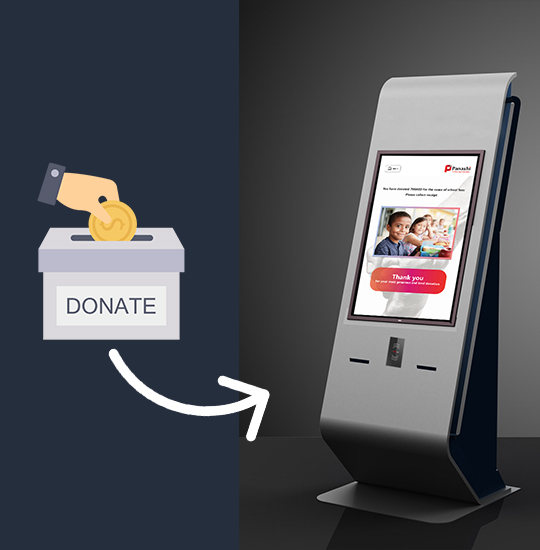How Donation Kiosks Are Changing the Way We Give

Donation kiosks are reshaping how people support causes that matter. These self-service machines offer a secure and simple way to give, especially in public spaces like malls, churches, hospitals, and nonprofit events. Unlike traditional donation boxes, they accept cards and mobile payments, making it easy for donors to give on the spot.
Many charities are adding donation kiosks to meet the needs of a cashless society. Research by the National Philanthropic Trust shows that 63% of donations today are made electronically. This shift in behavior means organizations must adapt if they want to keep donations steady. With fewer people carrying cash and more people relying on digital payment systems, the ability to donate quickly and safely has become essential.
Why People Prefer Donation Kiosks
1. No Cash Needed
Fewer people carry cash, which makes traditional donation boxes less effective. Donation kiosks accept credit cards, debit cards, and even contactless payments like Apple Pay or Google Pay. This convenience increases the chance of receiving donations from people who wouldn’t usually give. It removes the barrier of having to plan or carry spare change.
2. Fast and Easy Process
A quick tap and a few clicks are all it takes. Donation kiosks guide donors through a simple process, often completed in under 30 seconds. For busy donors, this speed matters. The fewer steps involved, the more likely a person is to complete the transaction without hesitation or confusion.
3. Safe and Secure Giving
Unlike physical donation boxes that can be tampered with or stolen, donation kiosks are encrypted and secure. They process payments just like a retail checkout, giving donors peace of mind. Trust is crucial in the donation process, and kiosks help build that trust by offering a method that feels both modern and reliable.
4. Clear Messaging and Branding
Kiosks can display images, videos, and messages that help people understand the cause instantly. This visual support builds trust and can lead to higher donations. A kiosk that shows exactly where the money goes or who it helps creates a more emotional and immediate response from donors.
What Charities Gain From Using Donation Kiosks
1. 24/7 Fundraising Potential
Donation kiosks can work around the clock without the need for staff. This means a charity can collect funds even when the office is closed or the event is over. Whether it’s a hospital lobby at night or a church open on weekends, the kiosk continues to receive donations without human assistance.
2. Better Donor Tracking
Unlike anonymous cash drops, digital donations provide useful data. Charities can learn when people give, how much, and even capture email addresses for future campaigns. This information is valuable for improving outreach and building stronger relationships with supporters over time.
3. Fewer Operational Risks
Cash handling comes with theft risk and requires time to count, store, and deposit. Donation kiosks remove this hassle with automatic digital transfers to the organization’s account. Staff no longer have to manage physical money or make extra trips to the bank, reducing stress and potential errors.
4. Professional Appeal
A modern, well-placed kiosk shows that an organization is organized and up-to-date. This can impress both one-time donors and long-term sponsors. Donors are more likely to contribute when they feel the organization is efficient and trustworthy.
Use Cases That Prove the Value of Donation Kiosks
Hospitals and Clinics
Donation kiosks in hospital lobbies let families and patients contribute while they wait. Some major hospitals report 25–35% more donations after adding kiosks. These kiosks offer a chance to give back in moments of gratitude, such as after receiving care or witnessing staff compassion.
Religious Institutions
Churches and temples use them for weekly collections. According to a Giving USA report, religious organizations receive the largest share of charitable donations in the U.S., and kiosks help keep this strong. Regular attendees and even visitors can contribute quickly and discreetly using their cards or phones.
Animal Shelters
Shelters use kiosks at adoption events and front desks. With images of animals in need, donors feel more connected and inspired to give. These kiosks can show success stories or current needs, encouraging people to give even if they’re not adopting a pet.
Disaster Relief
During emergencies like floods or earthquakes, kiosks can be set up in shopping centers or transit hubs. They allow for immediate giving when emotions are high and action is needed. People want to help quickly in times of crisis, and kiosks give them a way to do so within moments.
How to Maximize the Impact of Donation Kiosks
1. Choose High Traffic Locations
Placing kiosks where people gather—like malls, festivals, or hospitals—ensures more people will see and use them. The more eyes on the kiosk, the more donations an organization is likely to receive. Ideal locations are those where people often wait or have a few extra minutes.
2. Keep the Interface Simple
Clear instructions, minimal steps, and multiple payment options make it more likely someone will complete the donation. Avoid complex menus or too many choices. A donation flow with three simple screens can make a big difference in completion rates.
3. Update Content Regularly
Changing the images or messages every few weeks helps draw attention. New campaigns or urgent needs should be highlighted. People are more likely to interact with content that looks fresh and relevant. Even small updates can help maintain interest over time.
4. Offer Receipts and Thank Yous
Some kiosks print or email receipts. A thank-you message on screen can help make the donor feel appreciated instantly. This small gesture can encourage repeat giving and help donors feel seen, even without face-to-face interaction.
Challenges and How to Address Them
Initial Costs
Kiosks can cost from a few hundred to several thousand dollars, depending on features. However, many companies now offer rental options or monthly plans. This lowers the barrier to entry for smaller organizations or those testing the waters before a full rollout.
Technical Support
Nonprofits may worry about setup or maintenance. The good news is that most vendors provide remote support, and the machines are built for ease of use. Most issues can be resolved quickly with minimal downtime, making it a reliable fundraising tool.
Training Staff
Though kiosks are simple, staff should be ready to explain them. Just a few minutes of training can help teams feel confident. Staff can also help collect informal feedback to understand what works best and where improvements could be made.
What the Numbers Say
A study by Blackbaud found that nonprofits that use donation kiosks raise to 20% more during events than those that rely on traditional methods. In churches, electronic giving makes up nearly 50% of total donations in congregations that use kiosks. These trends show that people trust and prefer this method when it’s available.
Another report from Nonprofit Tech for Good indicated that 54% of millennial donors are more likely to give if the process is digital and quick. Since this group is becoming a key donor demographic, adapting to their preferences with donation kiosks can mean more consistent long-term support.
The Future of Donation Kiosks
With rising demand for contactless and fast transactions, donation kiosks are becoming a standard part of fundraising. As younger generations get involved in charitable giving, their preference for digital interaction makes kiosks a smart investment. Whether it’s Gen Z scanning a QR code or a retiree tapping a card, convenience matters.
Tech companies are developing AI-enabled kiosks that suggest donation amounts or offer campaigns based on time of day or event type. While these features are new, they could increase personalization and make each donation feel more impactful. Personalized content and timely appeals are already showing early promise in pilot programs.
FAQs
1. What types of payments do fundraising kiosks accept?
Most support credit cards, debit cards, and contactless options like Apple Pay or Google Pay.
2. Are the giving kiosks secure for donors?
Yes, they use encrypted payment systems similar to retail checkouts, ensuring data safety.
3. Where should these kiosks be placed for the best results?
High-traffic areas like hospital lobbies, malls, and event venues yield the most donations.
4. Can nonprofits track donations from these machines?
Yes, digital donations offer real-time tracking, donor data, and better campaign insights.
5. Are they suitable for small organizations?
Yes, many providers offer affordable plans or rentals to fit limited budgets.
Conclusion
Donation kiosks are changing the way people give—and the way nonprofits raise funds. With their ease of use, secure payment options, and data-friendly features, they offer a smarter approach to fundraising. As the world moves further into cashless and fast transactions, donation kiosks will play a key role in helping organizations reach their goals. Their potential is not just in collecting funds but in creating meaningful moments of giving that are timely, trusted, and effective.









